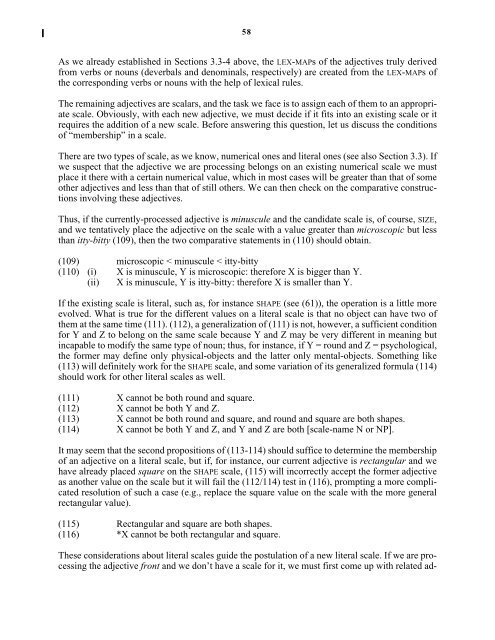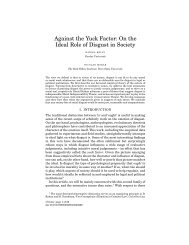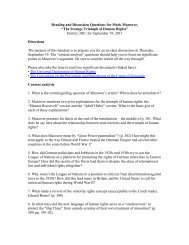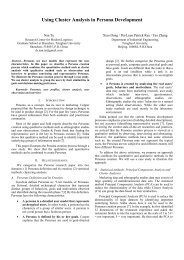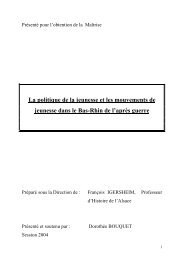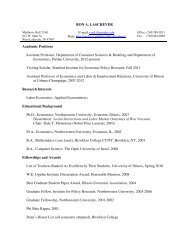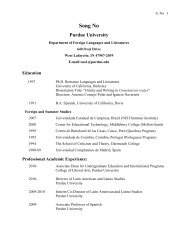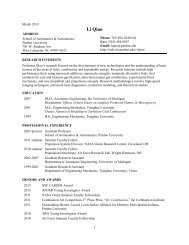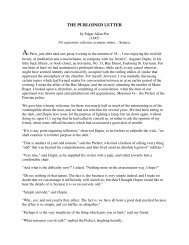Lexical Semantics of Adjectives - CiteSeerX
Lexical Semantics of Adjectives - CiteSeerX
Lexical Semantics of Adjectives - CiteSeerX
Create successful ePaper yourself
Turn your PDF publications into a flip-book with our unique Google optimized e-Paper software.
58<br />
As we already established in Sections 3.3-4 above, the LEX-MAPs <strong>of</strong> the adjectives truly derived<br />
from verbs or nouns (deverbals and denominals, respectively) are created from the LEX-MAPs <strong>of</strong><br />
the corresponding verbs or nouns with the help <strong>of</strong> lexical rules.<br />
The remaining adjectives are scalars, and the task we face is to assign each <strong>of</strong> them to an appropriate<br />
scale. Obviously, with each new adjective, we must decide if it fits into an existing scale or it<br />
requires the addition <strong>of</strong> a new scale. Before answering this question, let us discuss the conditions<br />
<strong>of</strong> “membership” in a scale.<br />
There are two types <strong>of</strong> scale, as we know, numerical ones and literal ones (see also Section 3.3). If<br />
we suspect that the adjective we are processing belongs on an existing numerical scale we must<br />
place it there with a certain numerical value, which in most cases will be greater than that <strong>of</strong> some<br />
other adjectives and less than that <strong>of</strong> still others. We can then check on the comparative constructions<br />
involving these adjectives.<br />
Thus, if the currently-processed adjective is minuscule and the candidate scale is, <strong>of</strong> course, SIZE,<br />
and we tentatively place the adjective on the scale with a value greater than microscopic but less<br />
than itty-bitty (109), then the two comparative statements in (110) should obtain.<br />
(109) microscopic < minuscule < itty-bitty<br />
(110) (i) X is minuscule, Y is microscopic: therefore X is bigger than Y.<br />
(ii) X is minuscule, Y is itty-bitty: therefore X is smaller than Y.<br />
If the existing scale is literal, such as, for instance SHAPE (see (61)), the operation is a little more<br />
evolved. What is true for the different values on a literal scale is that no object can have two <strong>of</strong><br />
them at the same time (111). (112), a generalization <strong>of</strong> (111) is not, however, a sufficient condition<br />
for Y and Z to belong on the same scale because Y and Z may be very different in meaning but<br />
incapable to modify the same type <strong>of</strong> noun; thus, for instance, if Y = round and Z = psychological,<br />
the former may define only physical-objects and the latter only mental-objects. Something like<br />
(113) will definitely work for the SHAPE scale, and some variation <strong>of</strong> its generalized formula (114)<br />
should work for other literal scales as well.<br />
(111) X cannot be both round and square.<br />
(112) X cannot be both Y and Z.<br />
(113) X cannot be both round and square, and round and square are both shapes.<br />
(114) X cannot be both Y and Z, and Y and Z are both [scale-name N or NP].<br />
It may seem that the second propositions <strong>of</strong> (113-114) should suffice to determine the membership<br />
<strong>of</strong> an adjective on a literal scale, but if, for instance, our current adjective is rectangular and we<br />
have already placed square on the SHAPE scale, (115) will incorrectly accept the former adjective<br />
as another value on the scale but it will fail the (112/114) test in (116), prompting a more complicated<br />
resolution <strong>of</strong> such a case (e.g., replace the square value on the scale with the more general<br />
rectangular value).<br />
(115) Rectangular and square are both shapes.<br />
(116) *X cannot be both rectangular and square.<br />
These considerations about literal scales guide the postulation <strong>of</strong> a new literal scale. If we are processing<br />
the adjective front and we don’t have a scale for it, we must first come up with related ad-


